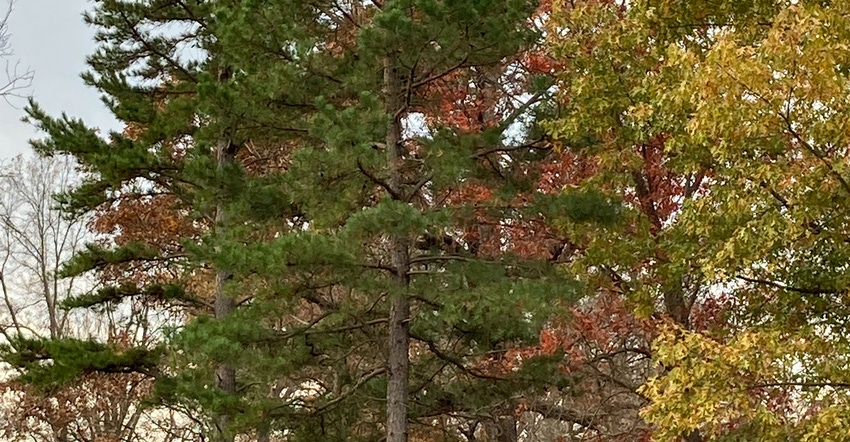November 20, 2020

Nothing compares to the quietude within the grove: the ancient smell of resin, the stark red and black bark plates on tall trunks, the springy cushion under foot and the soft hiss of wind moving through a canopy of shortleaf pines.
A grove is created when several evergreen trees grow close together, with tall tree trunks repeated far and wide. Over time, these trees form something greater than the sum of their parts — a sanctuary.
A place where warblers hunt for caterpillars in spring. A place where monarch butterflies rest during their fall migration. A place where red-cockaded woodpeckers once pecked holes. And now, a place where this author can retreat for a rare moment of silence. These are among my favorite places. They can be yours, right in your own yard.
Shortleaf pine is a fast-growing evergreen. A 10-year-old seedling stands 20 feet tall in good soil near my office. Thirty-year-old trees can reach up to 40 feet tall with lower branches 15 to 20 feet off the ground in shade.
The shortleaf pine is great option to use when creating a grove.
Establish a grove with pine
Plant shortleaf pines close together at random distances apart, ranging from 10 to 20 feet. To replicate a grove, plant 15 to 20 in the front or backyard of a half-acre lot, depending on other existing trees. This may seem like overplanting, but it works well.
On the other hand, a single tree fits nicely into narrow places because they grow strongly upright. Keep in mind that they have poorly developed lower branches, and are not good for screening. They can grow in the shade of existing mature trees or in full sun. In shade, they grow taller and narrower, with fewer branches. In full sun, they grow more densely.
Shortleaf pines tolerate a wide range of soil conditions, from sand to clay, and can grow directly on cliff faces. They are very drought tolerant. They will not tolerate poorly drained wet soil. They have relatively few ropelike roots that spread beyond the dripline of the branches. Because of this, they are easy to garden under.
Excellent companion plants that tolerate part shade and slightly acidic soil include purple coneflower, hoary skullcap, yellow wing stem, littleflower alumroot, purple aster, cliff goldenrod, switchgrass, beautyberry, serviceberry and mountain azalea.
By allowing the needles to fall in place as a mulch, soil acidity will increase slightly over several years, increasing the vigor of slow-growing, acid-loving azaleas.
Watch for problem pines
Shortleaf pine is the only native pine species growing wild in Missouri and can be found scattered throughout the Ozark Mountains. They grow as far north as Jefferson County.
White pine, a non-native from the northeastern U.S., does not thrive in the state.
White pine is more prone to wind and ice damage during storms because it has long branches. It is sensitive to summer heat, urban pollution, salt spray in winter and performs poorly in compact clay soils. However, shortleaf pine has none of these problems, plus it is an incredibly long-lived tree — some living 300 years.
Investing in short-leaf pine pays big dividends for future generations, plus it’s satisfying in the short run because it grows so fast and is easy to grow. Gardeners would enjoy a single tree or several plated in a grove. They are available through private nurseries, as well as the Missouri Department of Conservation. They offer bundles of small bare-root tree seedlings that can be ordered online in winter with delivery in spring.
Find suppliers of shortleaf pines and other native plant resources at grownative.org.
Woodbury is the curator of the Whitmire Wildflower Garden at Shaw Nature Reserve in Gray Summit, Mo., and an adviser to the Missouri Prairie Foundation’s Grow Native! program.
About the Author(s)
You May Also Like




